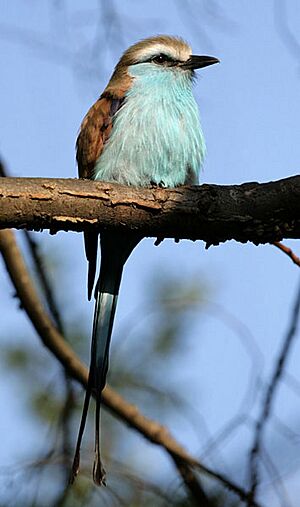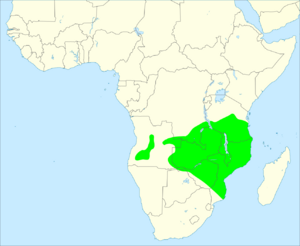Racket-tailed roller facts for kids
Quick facts for kids Racket-tailed roller |
|
|---|---|
 |
|
| Conservation status | |
| Scientific classification | |
| Genus: |
Coracias
|
| Species: |
spatulatus
|
 |
|
| Geographic distribution shown in green | |
| Synonyms | |
|
|
The racket-tailed roller (Coracias spatulatus) is a colorful bird that lives in southern Africa. You can find it in countries like Angola, the Democratic Republic of Congo, Tanzania, Botswana, Zimbabwe, Malawi, and Mozambique. This bird belongs to a family called Coraciidae, which are known for their bright feathers.
Contents
About the Racket-tailed Roller's Name
The racket-tailed roller was officially named in 1880 by a scientist named Roland Trimen. He gave it the scientific name Coracias spatulatus. This name comes from a Latin word meaning "spoon-shaped." This is because of the special feathers on its tail.
Scientists have studied the DNA of these birds. They found that the racket-tailed roller is most closely related to the purple roller.
Sometimes, people call this bird by other names. These include the Angola racket-tailed roller or Weigall's roller. This bird is considered a "monotypic" species. This means there are no different types or subspecies of the racket-tailed roller.
The phylogenetic relationships among the Coracias species are shown below, from the molecular study by Johansson et al. (2018)
| Coracias |
|
||||||||||||||||||||||||||||||||||||||||||||||||
What Does the Racket-tailed Roller Look Like?
The racket-tailed roller gets its name from its unique tail. It has long outer feathers that look like streamers. These streamers end in paddle-shaped tips, like tiny rackets!
This bird is about 28 to 30 centimeters (11 to 12 inches) long. Its tail streamers add another 8 centimeters (3 inches) to its length.
Let's look at its colors:
- Its forehead and eyebrows are white.
- The top of its head is a dull green.
- Its back is a reddish-brown color.
- Its tail is a beautiful blue.
- The feathers on its belly are pale blue with whitish stripes.
When the bird flies, you can see its purple upper wings. They have a bright azure-blue stripe. The underside of its wings is pale blue. It has a purplish-black edge and tip.
The racket-tailed roller looks a bit like the European roller or the lilac-breasted roller. But those birds do not have the special tail streamers. The racket-tailed roller has a black beak and brownish eyes. Its legs are a dull yellowish color.
Young racket-tailed rollers look similar to the adults. However, their colors are not as bright. They also do not have the long, thin tail feathers yet. When this bird swoops down, it makes a loud, harsh, gurgling shriek.
How the Racket-tailed Roller Lives
Just like other birds in the Coracias family, this roller hunts from a high spot. It likes to sit on a branch in the middle part of the trees in the forest. When it sees something tasty on the ground, it swoops down quickly to catch it.
Its diet mainly includes:
- Grasshoppers
- Beetles
- Insect larvae (young insects)
- Scorpions
- Small lizards
This roller usually lives alone or in pairs. Sometimes, you might see small groups of six or seven birds together. They are very protective of their space. If another bird comes too close, the roller will fly up high. Then it will rocket down with a loud screech. It rolls from side to side as it flies level. This helps it gain speed to rise back to a perch.
Racket-tailed Roller's Reproduction and Nesting
Racket-tailed rollers build their nests inside holes in tree trunks or branches. They usually choose a spot about 7 meters (23 feet) off the ground. They often use old nests that woodpeckers or barbets used before.
The female lays her eggs inside the empty tree cavity. She does not add any soft lining to the nest. Usually, she lays three or four eggs. Scientists do not know a lot about the nesting habits of this bird.
Is the Racket-tailed Roller in Danger?
The racket-tailed roller is a fairly common bird. It lives across a very large area. However, the number of these birds is thought to be going down. This is because their forest homes are being lost. This is especially true for miombo and mopane woodlands.
Even with this decline, no major threats have been found. The International Union for Conservation of Nature (IUCN) checks on animals around the world. They have decided that the racket-tailed roller is a "least concern" species. This means it is not currently in danger of disappearing.


